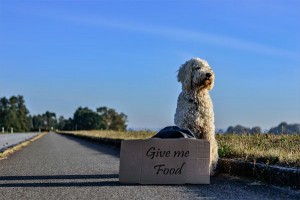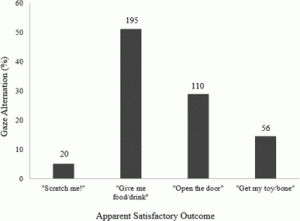 A recent study by researchers at the University of Salford has found compelling evidence that dogs use gestures in order to communicate with their humans. And, as you’d guess, the most observed gestures were noted to be the dogs asking for food or drink, asking to be scratched, asking for the door to be opened and asking for a toy or bone. This may seem quite obvious to us, but the results are really quite interesting.
A recent study by researchers at the University of Salford has found compelling evidence that dogs use gestures in order to communicate with their humans. And, as you’d guess, the most observed gestures were noted to be the dogs asking for food or drink, asking to be scratched, asking for the door to be opened and asking for a toy or bone. This may seem quite obvious to us, but the results are really quite interesting.
The study looked at 19 different reference actions and graded them against these 4 main “requests”. These actions were:
- Roll over – Rolling onto one side of the body and exposing the chest, stomach and groin
- Head under – Plunge headfirst underneath an object or human
- Head forward – Move the head forwards and up to direct a human’s appendage to a specific location on the body
- Hind leg stand – Lift front paws off the ground and stand on hind legs, front paws are not resting on anything
- Head turn – Head is turned from side to side on the horizontal axis usually between a human and an apparent object of interest
- Shuffle – Shuffle whole body along the ground in short movements, performed whilst in roll over position
- Back leg up – Lifting of a single back leg whilst lay on one side of the body
- Paw hover – Hold one paw in mid-air whilst in a sitting position
- Crawl under – Move entire or part of body underneath an object or a human’s appendage
- Flick toy – Hold toy in the mouth and throw it forwards, usually in the direction of a human
- Jump – Jump up and down off the ground, human or an object, usually while staying in one location
- Paw reach – Placing a single paw or both paws underneath another object to retrieve an object of apparent interest
- Nose – Pressing nose (or face) against an object or human
- Lick – Licking an object or human once or repetitively
- Front paws on – Lifting both paws off the ground and resting them on an object or human
- Paw rest – Lifting a single front paw and resting it on an object or human
- Head rub – Involves rubbing the head against an object or human on which the signaller is leaning on
- Chomp – Involves opening the mouth and placing it over the arm of a human whilst repeatedly and gently biting down on the arm
- Paw – Lifting of a single front paw to briefly touch an object or human
 Surprisingly enough, the vast majority of dog gestures were used as a way to ask for either food or drink, but these are the lists of what dogs are asking for and the gestures they may use to let you know (definitions of each are in the list above):
Surprisingly enough, the vast majority of dog gestures were used as a way to ask for either food or drink, but these are the lists of what dogs are asking for and the gestures they may use to let you know (definitions of each are in the list above):
“Scratch me”
- Rolling over
- Nosing
- Licking
- Paw rest
- Chomping
- Shuffling
- Back leg up
- Head rubbing
“Give me food/drink”
- Head forwards
- Paw hover
- Head turn
- Hind leg stand
- Flick toy
“Open the door”
- Front paws on
- Jumping
“Get my toy/bone”
- Paw rest
- Head under
- Paw reach
- Crawl under
We all feel that we can talk to our dogs and that they’re often trying to tell us something. Well, now we know for sure!
To read the full study and its results, click this link:
https://link.springer.com/article/10.1007%2Fs10071-018-1181-3
